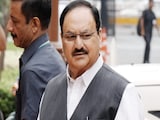India is a rising power in research and development but surprisingly, women constitute less than 20 percent of its scientific workforce. India aspires to become a developed country by 2047 and women scientists are now seeking parity with men in research and development.
Science Minister Jitendra Singh recently told the Rajya Sabha, "In India, there are 56,747 full-time equivalent of women employed in R&D in the total workforce of 3,41,818 which is 16.6% of total S&T workforce. However, their overall participation as workforce including research, auxiliary and administrative role in R&D establishments is about 18.8%."
Ideally, women's participation should be 50 percent and the government is making a concerted effort to bring in gender balance through special women-centric schemes.
A few weeks ago, India's women scientists launched a women-centric portal to showcase their achievements. The portal is called 'SWATI' (Science for Women-A Technology & Innovation) and represents Indian women and girls in STEMM (Science, Technology, Engineering, Mathematics, and Medicine). Over 3,000 women researchers have already showcased their work here.
India is not very different from the world, some of the global statistics also present a bleak picture. Between 1901-2023, out of the 970 Nobel prizes that were awarded, only 65 went to women, a mere 6.7%. In Computer Science, the Turing Award given since 1966 saw only 3 women recipients out of 76. Similarly, the Fields Medal - considered the Nobel Prize in mathematics - has been awarded to only two women since 1936.
The figures aren't any better for India. A study indicates that since 1958, when the prestigious Bhatnagar Awards in science were first given out, only 19 of the 583 winners have been women. Bhatnagar Awards are one of the most coveted awards in science in India.
There is a remarkable gender gap in top leadership positions in India and women seem to be treated unfairly.
The largest civilian research organisation of India, the Council of Scientific and Industrial Research (CSIR), established 81 years ago in 1942, got its first woman director general in Dr N Kalaiselvi only in 2022. The Department of Atomic Energy, the Indian Space Research Organisation (ISRO), and the Defence Research and Development Organisation (DRDO) are yet to see women heading these prestigious scientific institutions.
A study indicates that India tops the world in producing women graduates in STEM but ranks 19th in employing them. Prof Rohini Godbole, a high energy physicist from the Indian Institute of Science, Bengaluru and author of the book 'Lilavati's Daughters: The Women Scientists of India' says, "India has a leaky pipeline and talented women drop out of the scientific workforce mostly due to familial responsibilities."
While asking for parity, some women science achievers like Prof Sanghamitra Bandyopadhyay, Director, Indian Statistical Institute, Kolkata, assert that efforts should be made to bring parity even in childcare roles. She says the current government rule of giving two-year special leave for 'childcare' should be equally divided between the parents and it should not be inter-swappable. Men should also have equal play in childcare as this increases their bonding with the children, she asserts.
The heartening fact is that the rising women power, or Nari Shakti, is playing a significant role in India's prestigious space missions with many 'sheroes' occupying important positions at ISRO. The making of India's maiden space-based solar observatory, the Aditya L1 satellite, was spearheaded by a talented woman engineer, Nigar Shaji.
Earlier, scientist M Vanitha led the Chandrayaan-2 mission and Thenmozhi Selvi K led the making of the earth imaging satellite OceanSAT. Kalpana K is the deputy project director for the highly successful and ongoing Chandrayaan-3 mission. This correspondent has seen that on the shop floor and clean rooms of ISRO, men and women work shoulder to shoulder to bring glory to India.
India also had its own 'Agni Putri' in Tessy Thomas, who led the country's potent missile development program successfully. Dr Renu Swarup, as secretary of the Department of Biotechnology, ably led India's COVID-19 response while Dr Soumya Swaminathan became the chief scientist at the World Health Organisation (WHO), Geneva at the peak of the pandemic and helped the world fight and thwart the worst pandemic of the 21st century.
This shows that Indian women scientists excelled at every opportunity they got.
Contrary to what many believe that there is a gender bias at the Department of Space, Nigar Shaji had earlier asserted while speaking to NDTV, "There is no glass ceiling for women at ISRO". "At ISRO, only talent matters, gender plays no role," she had said.
The Ministry of Science and Technology acknowledges that women constitute 50% of human resources, which is vital for the progress of society, and that women scientists can provide opportunities by making institutions aware of several scientific and societal issues, thus bridging the gender gap and removing the barriers of negativity.















